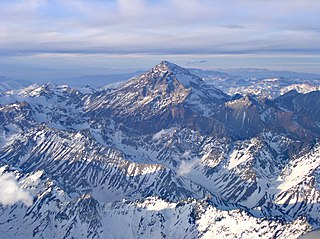
Mendoza, officially Province of Mendoza, is a province of Argentina, in the western central part of the country in the Cuyo region. It borders San Juan to the north, La Pampa and Neuquén to the south, San Luis to the east, and the republic of Chile to the west; the international limit is marked by the Andes mountain range. Its capital city is the homonymous city of Mendoza.
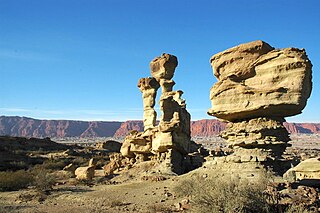
San Juan Province is a province of Argentina, located in the western part of the country. Neighbouring provinces are, moving clockwise from the north, La Rioja, San Luis and Mendoza. It borders with Chile to the west.

La Rioja is a province of Argentina located in the west of the country. The landscape of the province consist of a series of arid to semi-arid mountain ranges and agricultural valleys in between. It is in one of these valleys that the capital of the province, the city of la La Rioja, lies. Neighboring provinces are from the north clockwise Catamarca, Córdoba, San Luis and San Juan. The dinosaur Riojasaurus is named after the province.

Elías Piña is one of the 32 provinces of the Dominican Republic, located in the westernmost part of the country, along the border with Haiti. It is divided into 6 municipalities and its capital city is Comendador. The Cordillera Central is found in the northern part of the province, and the Sierra de Neiba runs across the southern half. Between those two mountain ranges, there are several valleys formed by the Artibonite River and its tributaries.
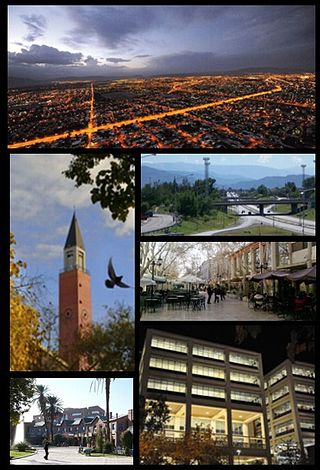
San Juan is the capital and largest city of the Argentine province of San Juan in the Cuyo region, located in the Tulúm Valley, west of the San Juan River, at 650 m (2,133 ft) above mean sea level, with a population of around 112,000 as per the 2001 census [INDEC].

Cuyo is the wine-producing, mountainous region of central-west Argentina. Historically it comprised the provinces of San Juan, San Luis and Mendoza. The modern New Cuyo includes both Cuyo proper and the province of La Rioja. New Cuyo is a political and economic macroregion, but culturally La Rioja is part of the North-West rather than of Cuyo.
Departments form the second level of administrative division, and are subdivided in municipalities. They are extended in all of Argentina except for the Province of Buenos Aires and the Autonomous City of Buenos Aires, the national capital, each of which has different administrative arrangements.

Ischigualasto Provincial Park, also called Valle de la Luna, due to its moon like appearance, is a provincial protected area in the north-east of San Juan Province, north-western Argentina, limiting to the north with the Talampaya National Park, in La Rioja Province. Both areas belong to the same geological formation, the Ischigualasto Formation . Established on 3 November 1971, the park has an area of 60,370 ha.

The San Juan River is, together with the Jáchal, the most important river of the Argentine province of San Juan. Both join the Desaguadero/Colorado system that ends at the Atlantic Ocean.
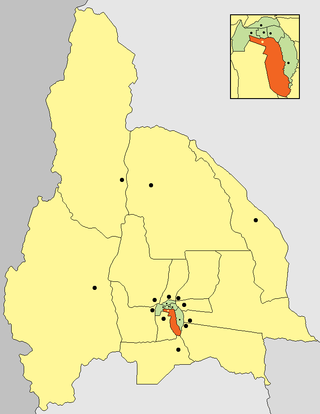
Rawson is a central department of San Juan Province in Argentina.

Sarmiento is a department located in the south west of San Juan Province in Argentina.
Villa Aberastain is an Argentine city of the province of San Juan, head of the department Pocito, and the headquarters of the municipal authorities of the department. Villa Aberastain is within the so-called Valley of Tulum, the main agricultural oasis in the province is concentrated and where 90% of the provincial population. The village is located about 15 kilometres from the low foothills of the Great St. John. National Route No. 40 passes a few kilometres east of the town and communicates with the provincial capital and the city of Mendoza.

Rivadavia is a department of the province of San Juan (Argentina). Located in the central southern part of Argentina, in the northeast section of the Valle del Tulum The city of San Juan is located in the west of this region, which is part of the conurbation, Grand San Juan. It is the capital city of the department of the same name, and is the government seat. It has various municipal edifices, including the police headquarters, and an important hospital, Marcial Quiroga.

Pocito is a department in San Juan Province, Argentina. It is located to the south of the city of San Juan, and is predominantly agricultural, the principal products being grapes and olives. It has a string of prestigious wineries that make up the so-called "Wine Route". The west part of the department is mountainous.

25 de Mayo is a department of the province of San Juan (Argentina), located southwest of the province. Be department is characterized by its high production wine and olivícola.

Nueve de Julio is a department of Argentina, located in the south-center of the province of San Juan. Lying within the Tulum Valley agricultural oasis, almost 80% of the department's area is cultivated; it is known in particular for its production of wine and its fruit and vegetable crops.

Calingasta is a department of the province of San Juan (Argentina). It is the southwestern corner of the province, which is predominantly a landscape of mountains and rivers. It is characterized by its production of apples and by tourism, mainly in the tourist towns of Barreal and Tamberías
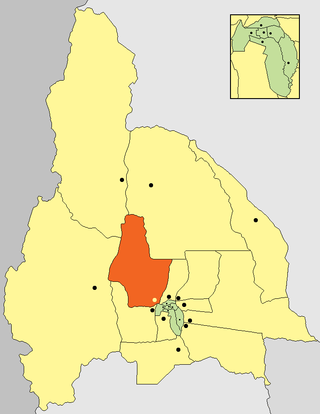
Ullum is a department of the Argentinean province of San Juan. It is located in the center of the province and its landscape is dominated by mountains and low vegetation. Its seat is Villa Ibáñez. It is also characterized by the production of grapes and fruit. The San Juan River is dammed by the Ullum Dam.
The National Day of the Sun is an annual celebration of nature that takes place in the City of San Juan and other locations in the San Juan province, Argentina, usually during the month of February. It gives a sample itinerary of economic activities, customs, characters and historical events of the province. It also highlights include a beauty contest, which elects the National Queen of the Sun and the Sun Virreina, candidates representing each of the nineteen departments of the province. The queen is chosen, and eventually Virreina, representing the province for one year, attending to other provincial and national holidays as well as tourism fairs and events to promote the province.

The Sierra del Tontal is a mountain range in the southern part of San Juan Province, Argentina.























